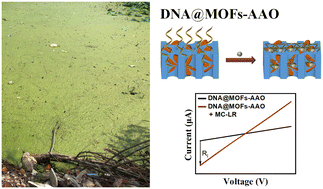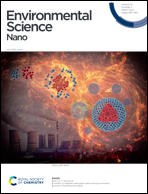In situ growth of metal–organic frameworks in nanochannels for highly sensitive microcystin-LR detection†
Abstract
Microcystin-LR (MC-LR) is a known hepatotoxin that is the most abundant and potent cyanobacterial toxin. The development of a strategy for sensitive MC-LR detection is highly demanded. In this work, a novel solid-state nanochannel-based sensing system was constructed by in situ growth of metal–organic frameworks (MOFs) on anodic aluminum oxide (AAO) nanochannels and modification with an MC-LR-specific aptamer as a probe. The MOF was employed to reduce the effective diameter of the nanochannels and provided abundant functional active sites for the probes. As a result, highly sensitive MC-LR detection was realized with the limit of detection reaching 0.004 ng mL−1. Compared to the nanochannels without MOF modification, the sensitivity has been significantly improved, by around 10 000-fold. Furthermore, highly reliable detection of MC-LR in various water samples was also achieved, with a relative standard deviation of less than 5.46% and recovery between 93.90% and 106.73%. This strategy provides significant insight for practical applications of nanochannel-based sensing systems, including environmental contaminant detection, food analysis, and medical analysis.

- This article is part of the themed collections: Nanomaterial applications in water and Environmental Science: Nano Recent HOT Articles


 Please wait while we load your content...
Please wait while we load your content...